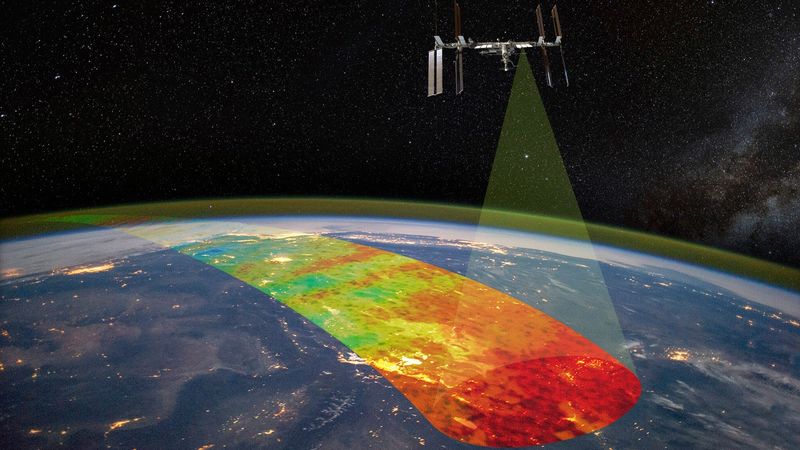
Space Dynamics Lab Achieves Critical Milestone for NASA Space Weather Mission
Utah State University’s Space Dynamics Laboratory announced that it has successfully completed the Key Decision Point (KDP) C for NASA’s Atmospheric Waves Experiment (AWE). KDP-C provides NASA approval for the project to begin final design and fabrication, known as Phase C, and establishes baselines for its official schedule and budget.
Planned to be ready for launch to the International Space Station in 2022, AWE will study atmospheric gravity waves in Earth’s atmosphere to gain deeper knowledge of the connections caused by climate systems through our atmosphere and between the atmosphere and space. The AWE mission is part of NASA’s Explorers Program under the Goddard Space Flight Center Explorers and Heliophysics Projects Division and is led by Principal Investigator Dr. Michael J. Taylor at Utah State University. The Space Dynamics Laboratory will build the AWE instrument and is also providing project management, systems engineering, safety and mission assurance, and mission operations.
“Banking, navigation, weather forecasting, and many other applications provided by satellites, as well as human space missions, can be affected by space weather,” Taylor said. “AWE will provide scientists with much needed information to better understand the physics and characteristics of atmospheric gravity waves in the Earth’s upper mesosphere and ionosphere—the region where space weather begins.”
Atmospheric gravity waves are formed by weather disturbances such as strong thunderstorms, hurricanes, or winds rushing upward over massive mountain ranges, such as the Rockies. They eventually deposit their energy, like an ocean wave breaking on the beach, as they ripple upwards into space. Gravity waves have not been well studied from space and their impacts are little understood, though they are known to affect the atmosphere, weather, and climate across the globe—as well as the weather in space.
“The approval of AWE’s path forward follows a rigorous review of all technical and programmatic aspects of the project and is a critical step as we begin fabricating and testing the instrument,” said Burt Lamborn, AWE project manager at SDL. “Under the leadership of NASA and Dr. Taylor, SDL is excited to execute this mission, which will provide crucial information about how terrestrial weather affects space weather.”
The upper atmosphere region that AWE surveys—called the mesopause—is Earth’s window to space weather: everything that impacts space weather from below passes through that window. The forces driving space weather in the upper atmosphere have practical repercussions given our ever-increasing reliance on space-based technology. AWE will provide important new data that can improve models and prediction capabilities for Earth’s atmosphere and space weather, which can affect weather, aviation, satellite operations and orbital lifetimes, communications signals, and astronauts in space.
As NASA plans missions to Earth’s moon, Mars, and beyond, AWE may influence research areas that include understanding how gravity waves can influence atmospheric regions beyond Earth and providing insight about the interactions between planets and stars throughout the universe.
AWE is a Mission of Opportunity under NASA’s Heliophysics Explorers Program, which conducts innovative, streamlined scientific investigations by developing instrumentation to answer focused science questions that augment and complement the agency’s larger missions. AWE joins a fleet of heliophysics missions positioned at key places around the solar system, which together seek to understand the way the constant outflow of energy and particles from our Sun affects interplanetary space – information that not only teaches us more about our astrophysical neighborhood, but helps protect astronauts and technology in space.
Utah State University’s Department of Physics is among six academic departments of the College of Science. As part of a land and space grant university, the college’s mission is to create, share and apply new knowledge to inspire scientific solutions to global challenges. USU physics students develop valuable research and critical-thinking skills with professors engaged in world-class research programs. For more information, visit www.physics.usu.edu
SDL has been solving the technical challenges faced by the military, science community, and industry for six decades and supports NASA’s mission to drive advances in science, technology, aeronautics, and space exploration to enhance knowledge, education, innovation, economic vitality and stewardship of Earth. As one of 14 University Affiliated Research Centers, SDL serves as a subject matter expert in its core research areas to the U.S. Government, ensuring that essential engineering and technology capabilities are maintained. SDL is a research laboratory headquartered in North Logan, UT, and has offices in Albuquerque, NM; Bedford, MA; Colorado Springs, CO; Dayton, OH; Huntsville, AL; Houston, TX; Los Angeles, CA; Stafford, VA; and Washington, DC. For more information, visit www.sdl.usu.edu.
Contact
- SDL Public Relations
- (435) 713-3054
- pr@sdl.usu.edu